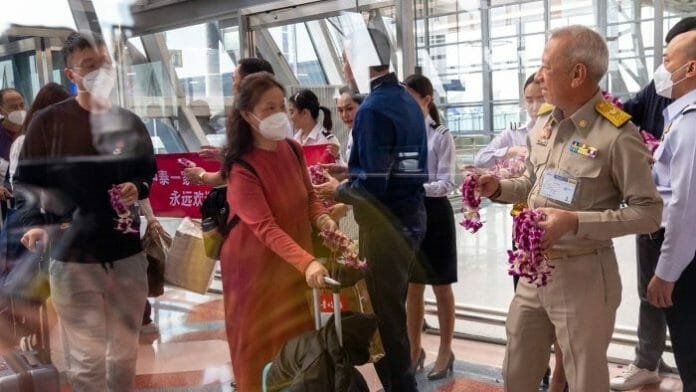Before the pandemic, China tourists were ASEAN-6’s largest source of arrivals, who took 27 million trips and contributed about US$32.4bn in tourism receipts to ASEAN-6 in 2019. The return of China tourists will help boost the hospitality, retail and aviation sectors, and cushion the manufacturing and export recession.
In Nov 2022, before the recent reopening, China accounted for only about 126k tourist arrivals in ASEAN6, or just 5.6% of pre-pandemic levels. Using the reopening and mean trajectory between Japan’s slow (lower bound) and Korea’s rapid (upper bound) outbound tourist recovery, Maybank Investment estimates China visitors to this region to reach 10.5 million in 2023 or 38% of pre-pandemic 2019 levels (far lower than the China Outbound Tourism Research Institute’s forecast of 59% outbound trips excluding Hong Kong & Macau).
The research house forecast nevertheless represents a 12x fold increase over 2022. By Dec 2023, it expects China visitors to reach 71% of pre-pandemic levels. Thailand will be the biggest beneficiary of China’s revenge travel. Prepandemic, China visitor arrivals accounted for 28% of total arrivals, while China tourism receipts accounted for 3.1% of Thailand’s GDP. Vietnam will be the second biggest beneficiary, where China visitor arrivals accounted for 31% of total arrivals, and China tourism receipts accounted for 1.4% of GDP. Malaysia, Singapore, and the Philippines will be more modest beneficiaries. Indonesia will benefit the least, with China’s tourism receipts accounting for only 0.2% of GDP. So far, the recovery in China tourists up to late 2022 has been faster in Indonesia (14% of pre-pandemic) and
Malaysia (11%), and slower in Vietnam (3%), and Thailand (5%).
ASEAN has broadly avoided stringent requirements targeted at China tourists, and will likely benefit from the diversion of China tourists away from Korea, Japan, and Australia, which imposed more stringent rules. Indonesia, Singapore and the Philippines only require proof of vaccination for all arrivals. Vietnam has no restrictions for all arrivals. Thailand requires only
Covid insurance. In Malaysia, only the state of Sabah requires a pre-departure test. Outbound Korean tourists have reached 50% of pre-pandemic levels, twice the 25% of outbound Japanese tourists. The recovery path of China’s outbound tourists will likely be somewhere in between Japan’s slow and Korea’s more rapid recovery. First, restrictions on outbound travel have not been fully dismantled. For example, sales of group package travel is still banned and passport renewal will take time. Second, high domestic infections will dampen travel. Third, many countries are imposing entry restrictions on Chinese travelers, including Japan, Korea, Australia, and the USA. Fourth, international flight capacity will take time to ramp up and ticket fares remain high. Fifth, Chinese consumers may be budget conscious in the initial years after finances were impacted by the pandemic. The counter– argument is the build-up in excess savings and potential “revenge spending”.
Maybank Investment is raising its China GDP growth forecast to +5% (from 4%) in 2023 given the faster-than-expected “big bang” reopening. ASEAN economies more sensitive to a China GDP recovery include Singapore, Vietnam, Malaysia, and Thailand. GDP growth forecasts for Thailand is raised significantly (+4% from +3.2%), Vietnam (+6.3% from +6%) and
Singapore (+1.7% from +1.5%) given the more positive China outlook.
China’s reopening increases the odds of ASEAN decoupling from a US and Europe recession.









